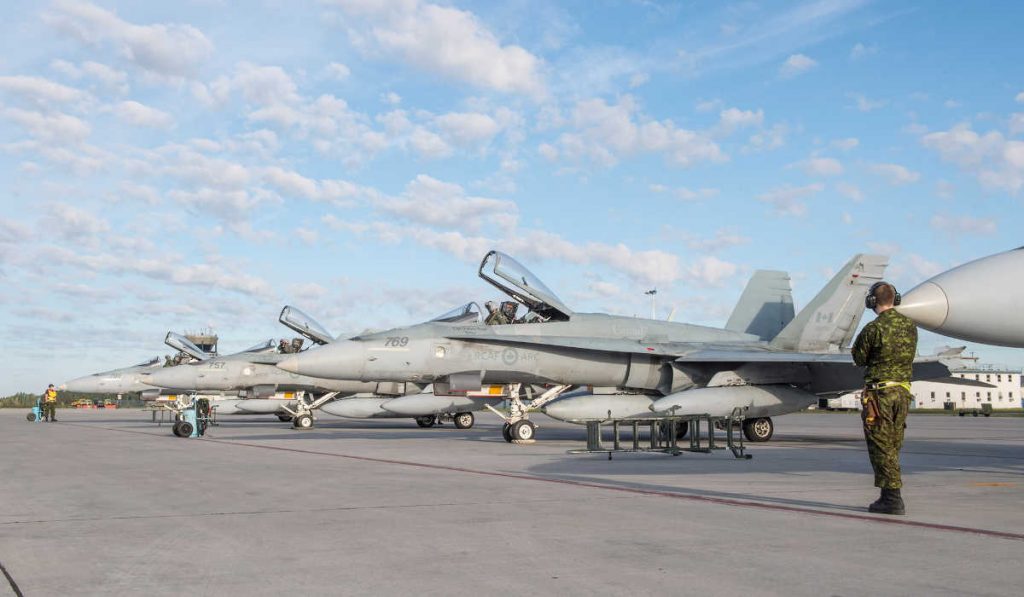
Features
Military
Canada not sending fighter jets to Europe next year as Air Force rearms, regroups
December 14, 2022 By Lee Berthiaume, The Canadian Press
 Canada’s Romanian air-policing mission includes an RCAF detachment of approximately 135 personnel and six CF-18 Hornet fighter jets. (Photo: Canadian Armed Forces)
Canada’s Romanian air-policing mission includes an RCAF detachment of approximately 135 personnel and six CF-18 Hornet fighter jets. (Photo: Canadian Armed Forces) OTTAWA — Canada will not send fighter jets to patrol NATO airspace for Russian incursions next year, the first time that Canadian CF-18s will be absent from the skies over Europe since 2017.
While the decision is being blamed on the need to upgrade the CF-18s and train more personnel, it has nonetheless raised eyebrows given the West’s current tensions with Russia and the ongoing war in Ukraine.
Canada first deployed a group of CF-18s to participate in what is known as the NATO air policing mission in 2014, as the military alliance scrambled to bolster its forces in eastern Europe following Russia’s annexation of Ukraine’s Crimean Peninsula.
Based out of Romania and working alongside other NATO aircraft, their mission was to monitor Russian air activity over the Baltics and Black Sea — and protect against any aggressive action by Moscow.
The Air Force started to send aircraft and personnel every year in 2017, with the most recent rotation ending on Dec. 1, as six CF-18s returned home from Romania following a four-month deployment in which they flew nearly 500 sorties.
Yet while there was an expectation that Canada would return next year, Defence Department spokesman Daniel Le Bouthillier confirmed in an email that will not be the case.
“While the RCAF remains ready to deploy NATO committed assets when required, we are not planning to participate in NATO air policing in 2023 at this time,” he said in a statement.
Many of the Air Force’s aircraft and personnel are currently tied up on “modernization activities,” Le Bouthillier said, which includes upgrading Canada’s aging CF-18s so they can fly and fight for the foreseeable future.
“Moreover, the RCAF is also focusing on training new and existing fighter pilots and technicians as part of our ongoing reconstitution efforts,” he added.
Canada’s auditor general warned in 2018 that the CF-18s risked being outmatched by more advanced adversaries due to a lack of upgrades since 2008. The Air Force has been working to add new weapons, sensors and defensive systems to the fleet.
Those upgrades come as the federal government continues negotiating the purchase of 88 F-35s, the first of which isn’t scheduled to arrive until at least 2025 and the last around 2032.
The Air Force has also been struggling with a shortage of pilots and technicians for years. A lack of experienced pilots, in particular, has forced it to walk a fine line between having enough seasoned aviators to train recruits and lead missions in the air.
The decision not to commit to another rotation next year nonetheless raised questions for University of Calgary defence analyst Jean-Christophe Boucher, who was in Romania on Dec. 1 to see the CF-18s take off for their return flight home.
Boucher said he talked to Romanian and French military personnel during his visit to the Mihail Kogalniceanu airbase, who expressed surprise and confusion at suggestions Canada would not be back in 2023.
“Everyone was telling us: `We don’t understand what it means, they’re not coming back,”’ he said. “Romania is very grateful (for) the commitment.”
Romania’s proximity to Ukraine, and the fact the Black Sea has become a front line in the war in Ukraine, also means Canada was playing a key role in checking Russian aggression and activity in the region, Boucher said.
Le Bouthillier noted that Canada did recently deploy three C-130 Hercules transport aircraft to the United Kingdom to help move NATO troops and equipment.
The government is also in talks with NATO allies about reinforcing a Canadian-led battlegroup in Latvia.
Yet the return of two minesweepers from a stint with a NATO task force last month has also left Canada without any warships in European waters for the first time since 2014. The government instead opted to send two frigates to the Indo-Pacific region.
That, combined with military-wide personnel shortage and the government’s recently announced Indo-Pacific strategy, has resulted in growing concerns that the Canadian Armed Forces is being stretched too thin.